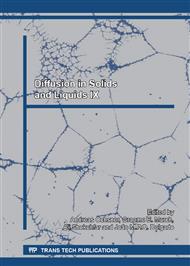p.153
p.159
p.165
p.171
p.177
p.183
p.189
p.193
p.199
Concentration Dependence of the Diffusion in the Ni/Cu System
Abstract:
Deviations from the Fickian-laws of diffusion in the case of concentration dependent diffusion coefficients and high composition gradients gain more and more acceptance nowadays. The cause of this phenomenon is the finite permeability of the atomic layers, or in other words “interface control”. The consequences are wide-spreading e.g. linear diffusion kinetics, deviations in the nucleation behavior of reaction products and kinetically determined interface shape in miscible alloys. Furthermore, if the original chemical interface is broader than the optimum width, even a sharpening of the interface by diffusion can be observed. Previous experiments proving these effects used more or less ideal specimens (e.g. single crystalline or amorphous samples with very flat interfaces) and some doubts can be raised whether these effects can be observed in a realistic specimen with a more complex grain structure. In this talk we will present the results of atom probe measurements on sputter deposited Ni/Cu multilayers (containing surface roughness, lattice defects, etc.). Samples with sharp and smeared Ni/Cu interfaces were produced and later annealed. We found an asymmetry on the interface width in the as-prepared specimens depending on the stacking order. After annealing this asymmetry vanished and remarkably the Cu/Ni interface sharpened by diffusion. After short diffusion time, the interface width became independent on the sample origin (sharp or smeared interface) proving the kinetic control of the interface. Atom probe tomography also allows the direct, local investigation of the grain boundary diffusion in any single grain boundaries. Surprisingly the best description of the shortcut transport can be achieved by assuming a concentration-independent grain boundary diffusion coefficient.
Info:
Periodical:
Pages:
177-182
Citation:
Online since:
May 2014
Authors:
Keywords:
Price:
Сopyright:
© 2014 Trans Tech Publications Ltd. All Rights Reserved
Share:
Citation:


